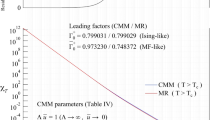Abstract
A challenging problem is to experimentally resolve the Yang-Yang dilemma for fluids-whether the critical singularity of the isochoric heat capacity is shared between the second temperature derivatives of pressure and chemical potentials. In the lattice-gas model, which serves as a well-established guidance to study fluid criticality, the divergence of the second derivative of pressure is solely responsible for the heat capacity anomaly. If it is proven that the heat capacity singularity is shared between the pressure and chemical potential derivatives, a revision of the conventional scaling theory for fluids based on the analogy between fluids and lattice-gas model will be required. Thus far, experiments on real fluids have been inconclusive, in particular, because of possible impurity effects and the intrinsic vapor-liquid asymmetry. A study of the 3He isotope gives a unique opportunity to resolve the Yang-Yang dilemma. In 3He all other impurities except 4He are frozen out. The almost perfect purity of the available 3He samples (typically less than 1 ppm of 4He in 3He) enables the elimination or quantitative study of impurity effects. Also the well-known symmetry of the 3He coexistence curve implies an absence of confluent singularities caused by liquid-gas asymmetry. In this paper we reanalyze early experimental data of near-critical 3He and show that they are internally not completely consistent. While the second derivative of chemical potential obtained from the density dependence of the two-phase isochoric heat capacity does not show a noticeable anomaly, the analysis of the same property obtained by combining the PVT and heat capacity implies the existence of the Yang-Yang anomaly. An unambiguous test of the Yang-Yang dilemma will require more accurate heat-capacity measurements closer to the critical point. To thoroughly distinguish between these alternatives one may ultimately require a microgravity experiment that will allow measurements very close to the critical point.
Similar content being viewed by others
REFERENCES
C. Domb and M.S. Green,eds.,Phase Transitions and Critical Phenomena,Academic, New York (1976),Vol.6.
M.E. Fisher,in Critical Phenomena,Lecture Notes in Physics 186,F.J.W. Hahn ed., Springer,Berlin (1982),p.1.
T.D. Lee and C.N. Yang,Phys.Rev.87,410 (1952).
J.V. Sengers and J.M.H. Levelt Sengers,in Progress in Liquid Physics,C.A. Croxton ed.,Wiley, New York (1978),p.103.
M.A. Anisimov, E.E. Gorodetskii, V.D. Kulikov,and J.V. Sengers,Phys.Rev.E 51, 1199 (1995).
N.D. Mermin and J.J. Rehr,Phys.Rev.Lett.26,1155 (1977);J.J.Rehr and N.D. Mermin,Phys.Rev.A 8,472 (1973).
M. Ley-Koo and M.S. Green,Phys.Rev.A 16,2483 (1977).
M.A. Anisimov and J.V. Sengers,in Equations of State for Fluids and Fluid mixtures, J.V. Sengers, R.F. Kayser, C.J. Peters,and H.J. White,Jr.eds.,Elsevier, Amsterdam (2000),p.381.
M.E. Fisher,Rev.Mod.Phys.70,653 (1998).
V.A. Agayan, M.A. Anisimov,and J.V. Sengers,Phys.Rev.E 64,0261125 (2001).
J.F. Nicoll,Phys.Rev.A 24,2203 (1981).
M. Ley-Koo and M.S. Green,Phys.Rev.A 23,2650 (1981).
F.C. Zhang and R.K.P. Zia,J.Phys.A 15,3303 (1982).
K.E. Neuman and E.K. Riedel,Phys.Rev.B 30,6615 (1984).
A. Kostrowicka Wyczalkowska, M.A. Anisimov,and J.V. Sengers,J.Chem.Phys.116, 4202 (2002).
C. Pittman, T. Doiron,and H. Meyer,Phys.Rev.B 20(9),3678 (1979).
M. Barmatz, Inseob Hahn, Fang Zhong, M.A. Anisimov,and V.A. Agayan,J.Low Temp.Phys.121,633,(2000).
C.N. Yang and C.P. Yang,Phys.Rev.Lett.13,303 (1964).
M.E. Fisher and G. Orkoulas,Phys.Rev.Lett.85,696 (2000).
G. Orkoulas, M.E. Fisher,and C. Üstün,J.Chem.Phys. 113,7530 (2000).
G. Orkoulas, M.E. Fisher,and A.Z. Panagiotopoulos,in Computer Simulation Studies in Condensed Matter Physics XIII,D.P. Landau, S.P. Lewis,and H.B. Schüttler eds., Springer, Berlin (2000),p.167.
G. Orkoulas, M.E. Fisher,and A.Z. Panagiotopoulos,Phys.Rev.E 13,051507 (2001).
M. Vicentini-Missoni, J.M.H. Levelt-Sengers,and M.S. Green,J.Res.N.B.S.73A, 563 (1969).
M.A. Anisimov, V.G. Beketov, V.P. Voronov, V.B. Nagaev,and V.A. Smirnov,in Ther-mophysical Properties of Substances(in Russian),USSR Bureau of Standards, Moscow, 16,48 (1982).
Kh. Amirkhanov and A.M. Kerimov,Teploenergetica 10(8)64 (1963).
A.V. Voronel,in Phase Transitions and Critical Phenomena,Vol.5B,C. Domb and M. S. Green eds.,Academic Press, New York (1976),p.343.
G.R. Brown and H. Meyer,Phys.Rev.A 6,364 (1972).
I.M. Abdulagatov, L.N. Levina, Z.R. Zakaryaev,and O.N. Mamchenkova,Fluid Phase Equilib.127,205 (1997).
E.M. Gaddy and J.A. White,Phys.Rev.A 26,2218 (1982).
N.G. Polikhronidi, R.G. Batyrova,and I.M. Abdulagatov,Int.J.Thermophys.21,1073 (2000).
R.P. Behringer, T. Doiron,and H. Meyer,J.Low Temp.Phys.24(3/4),315 (1976).
Y.C. Kim, M.E. Fisher,and G. Orkoulas,Phys.Rev.E 67,061506 (2003).
T. Doiron, R.P. Behringer,and H. Meyer,J.Low Temp.Phys.24(3/4),345 (1976).
R.P. Behringer,Ph.D.Thesis,p.99,Duke University (1995).
F. Zhong and H. Meyer,Phys.Rev.E 51,3223 (1995).
M.E. Fisher,Phys.Rev.176,237 (1968).
M.A. Anisimov, E.E. Gorodetskii,and N.G. Shmakov,Sov.Phys.JETP 36,1143 (1973).
J.C. Rainwater,in Supercritical Fluid Technology,T.J. Bruno and J.F. Ely eds.,CRC Press, Boca Raton,Fl (1991),p.57.
M.R. Moldover and J.S. Gallagher,AIChE J. 24,267 (1978).
Author information
Authors and Affiliations
Rights and permissions
About this article
Cite this article
Anisimov, M.A., Zhong, F. & Barmatz, M. Resolving the Yang-Yang Dilemma in 3He Near the Critical Point. Journal of Low Temperature Physics 137, 69–88 (2004). https://doi.org/10.1023/B:JOLT.0000044235.12902.f3
Issue Date:
DOI: https://doi.org/10.1023/B:JOLT.0000044235.12902.f3




